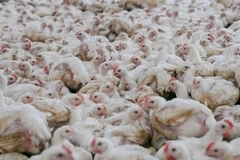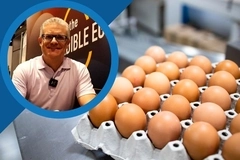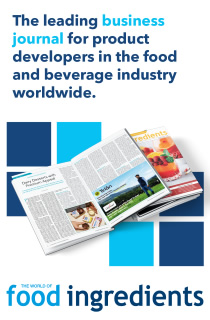Nosh.bio targets foodservice applications with Koji hybrid beef mince launch
Nosh.bio has launched its Koji-based hybrid beef mince applications in German foodservice, to demonstrate the potential of the non-GMO fungi-based alternative protein in hybrid meat applications.
This marks the “first” public demonstration of the product in partnership with Speisemanufaktur Adlershof restaurant in Berlin, where it is being incorporated into burgers, meatballs, and lasagna.
The company highlights the ingredient’s adaptability in different culinary formats and suitability for large-scale food production. It plans to collect real-time feedback on aspects such as flavor, texture, and overall performance.
Hybrid food products involve blending meat and alt-proteins and offer flexitarians and omnivores an opportunity to reduce meat consumption without excluding it completely. Nosh.bio says its hybrid mince has been developed to “match and surpass” pure beef in key areas, such as lower costs, and meat flavor and mouthfeel retention with improved juiciness.
Food Ingredients First speaks with Alix Chausson, Nosh.bio’s chief growth and commercial officer, to understand the techniques behind the product’s formulation, and why the “minced” format is ideal for introducing it in foodservice.
Why did you decide to focus on developing a hybrid mince product rather than going entirely plant-based or fully cultivated? What makes mince the right format for introducing Koji protein to the market?
Chausson: We chose to launch our Koji-Based Hybrid Beef Mince because minced beef is one of the largest and most widely consumed categories in the global meat industry. The market size of mince and its wide range of applications, from burgers to sauces, make it the ideal platform to introduce Koji protein and its benefits.
 A hybrid approach delivers beef taste with a smaller environmental footprint, says Chausson.Consumers are looking for food that is both delicious and better for the planet. A hybrid approach lets us deliver the full beef taste and texture people expect while significantly lowering the environmental footprint. Our Koji protein adds clean label functionality, dietary fiber, and improved nutrition, cutting saturated fat and cholesterol by over 30% at our inclusion rates while drastically reducing land, water, and carbon use compared to beef.
A hybrid approach delivers beef taste with a smaller environmental footprint, says Chausson.Consumers are looking for food that is both delicious and better for the planet. A hybrid approach lets us deliver the full beef taste and texture people expect while significantly lowering the environmental footprint. Our Koji protein adds clean label functionality, dietary fiber, and improved nutrition, cutting saturated fat and cholesterol by over 30% at our inclusion rates while drastically reducing land, water, and carbon use compared to beef.
For end consumers, there’s no compromise on taste or texture. For our B2B partners, Koji protein provides a cost-effective, more sustainable ingredient that supports both nutritional improvements and meaningful cost savings.
What culinary applications does the product have in the food industry?
Chausson: Our Koji-Based Hybrid Beef Mince is designed for flexibility across the food industry, making it suitable for a wide range of both retail and foodservice formats. It can be used in classic minced beef applications such as burgers, meatballs, lasagna, tacos, and sauces, but also extends naturally into ready meals and convenience products, where versatility and consistency are essential.
Because the ingredient can be easily integrated into existing production lines, it supports large-scale manufacturing and B2B partnerships. This makes it attractive not only to meat producers seeking hybrid options but also to manufacturers of ready-made meals, quick-service restaurants, and institutional catering, where cost savings, nutrition, and sustainability are increasingly important purchasing drivers. In short, the product is positioned as a drop-in solution for multiple categories — combining product versatility with industrial scalability.
Can you explain the process of developing the alt-protein product?
Chausson: Our Koji protein is produced through the fermentation of non-GMO fungi and grown on agricultural side-streams. The process is highly efficient, using minimal inputs of water and energy, and can be carried out using existing brewery facilities.
After the fermentation, we apply a streamlined downstream process that preserves the mycelium’s natural fiber alignment, giving the ingredient its authentic, meat-like texture. This enables us to deliver a clean label, nutrient-rich protein that integrates directly into existing production lines without the need for extrusion or heavy processing.
What challenges did the team face in formulating it, and how did you overcome them?
Chausson: The main challenge was achieving the right balance of taste, texture, and nutrition while ensuring consistency at scale. Filamentous fungi naturally provide a meat-like texture, but identifying the right strain — robust, safe, and nutritionally strong — required significant R&D.
 Koji protein is a sustainable, non-GMO fungi-based alternative grown on agricultural side-streams.From there, scaling the process was a matter of step-by-step trials with increasing volumes, which presented its own challenges like oxygen control. Additionally, we focused on finding the right harvesting strategy that delivers efficiency at scale while providing a product with the ideal qualities to be readily incorporated into multiple customer applications. By collaborating closely with equipment providers and CMOs, piloting and slowly increasing volumes, we overcame these hurdles and built a resilient, scalable platform for production.
Koji protein is a sustainable, non-GMO fungi-based alternative grown on agricultural side-streams.From there, scaling the process was a matter of step-by-step trials with increasing volumes, which presented its own challenges like oxygen control. Additionally, we focused on finding the right harvesting strategy that delivers efficiency at scale while providing a product with the ideal qualities to be readily incorporated into multiple customer applications. By collaborating closely with equipment providers and CMOs, piloting and slowly increasing volumes, we overcame these hurdles and built a resilient, scalable platform for production.
In blind tastings, how does the hybrid mince score on flavor, juiciness, and texture versus 100% beef?
Chausson: In consumer blind tastings, the majority-rated Hybrid Mince is equal to, or better than, 100% beef on flavor and mouthfeel. In recent customer sensory panels, 80% preferred the mouthfeel of the koji hybrid mince versus mince made with 100% beef. Sensory testing also showed it delivered a comparable bite and chew, with nutrition improved by around 30% less cholesterol, lower fat, added fiber, and beta-glucans, while protein content remained stable. These results give us confidence that the product can directly meet end consumers’ expectations.
The company says the product is cheaper than beef. Can you tell us how you achieved that?
Chausson: We achieve cost advantages in several ways. First, our fermentation process runs on low-cost agricultural feedstocks and doesn’t require energy-intensive extrusion or freeze-drying. It is inherently efficient; the fungi grow rapidly, with minimal downstream processing, which translates into lower unit costs and stable pricing even as global meat costs rise.
Central to cost reduction at scale will be the retrofitting of food-grade facilities like breweries, enabling us to cut CAPEX by over 80% and scale production six times faster than by building new plants.
What are your future plans for scaling hybrid mince into broader B2B channels?
Chausson: Our strategy is B2B-first, partnering with leading meat producers and food manufacturers to develop end products using the Nosh ingredient and integrating into their distribution networks. Our primary goal is getting products on supermarket shelves across Europe, supporting major retailers that have pledged to achieve a 50:50 plant-animal protein ratio by 2030.
The hybrid mince launch in Berlin is our first public launch through foodservice, and we’ll continue to expand in restaurants and foodservice in parallel with our B2B and retail focus. By scaling production through repurposed breweries and leveraging partners’ retail reach, we aim to make hybrid products an affordable, mainstream option. This will help the industry cut costs, meet sustainability targets, and win over consumers who want taste, price, and nutrition without compromise.


















